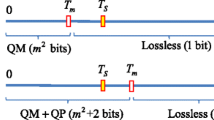Abstract
This paper presents an improved image steganography scheme based on absolute moment block truncation coding (AMBTC). The purpose of the proposed scheme is to achieve high payload, good visual quality and low computation complexity at the same time. In the scheme, a threshold is predefined to classify the blocks of the AMBTC-compressed codes as smooth or complex blocks, in which data are then embedded. For the smooth blocks, the bit planes of them are used to embed the data. Later, the two quantization levels in the smooth block are re-calculated to minimize the distortion in image quality. For the complex blocks, a proportion of secret bits are concealed by exchanging the order of two quantization levels with together toggling the bit plane, by which the payload can be increased without any distortion. Furthermore, the proposed scheme inherits the advantages of the AMBTC method, such as pleasing image quality, ease to be implemented and low computational complexity. With adjustable threshold, the application of the proposed scheme becomes flexible, that means different thresholds can be used for different applications. Experimental results and analysis demonstrate the effectiveness and superiority of the proposed scheme.






Similar content being viewed by others
References
Alattar AM (2004) Reversible watermark using the difference expansion of a generalized integer transform. IEEE Trans Image Process 13(8):1147–1156
Alturki F, Mersereau R (2001) Secure blind image steganographic technique using discrete fourier transformation. In: 2001 International Conference on Image Processing, vol. 2, pp. 542–545. IEEE
Balasubramanian C, Selvakumar S, Geetha S (2013) High payload image steganography with reduced distortion using octonary pixel pairing scheme. Multimed Tools Appl:1–23
Chan CK, Cheng LM (2004) Hiding data in images by simple lsb substitution. Pattern Recog 37(3):469–474
Chang CC, Chen TS, Chung LZ (2002) A steganographic method based upon JPEG and quantization table modification. Inform Sci 141(1C2):123–138
Chang CC, Kieu TD, Wu WC (2009) A lossless data embedding technique by joint neighboring coding. Pattern Recog 42(7):1597–1603
Chang CC, Lin CY (2006) Reversible steganography for vq-compressed images using side matching and relocation. IEEE Trans Inform Forensics Secur 1(4):493–501
Chang CC, Lin CY, Fan YH (2008) Lossless data hiding for color images based on block truncation coding. Pattern Recog 41(7):2347–2357
Chang CC, Yung-Chen C, Chih-Yang L (2007) Reversible data hiding in the vq-compressed domain. IEICE Trans Inf Syst 90(9):1422–1429
Chen J, Hong W, Chen TS, Shiu CW (2010) Steganography for BTC compressed images using no distortion technique. Imaging Sci J 58(4):177–185
Chen PY, Lin HJ (2006) A dwt based approach for image steganography. Int J Appl Sci Eng 4(3):275–290
Chuang JC, Chang CC (2006) Using a simple and fast image compression algorithm to hide secret information. Int J Comput Appl 28(4):329–333
Delp E, Mitchell O (1979) Image compression using block truncation coding. IEEE Trans Commun 27(9):1335–1342
Fridrich J, Goljan M, Du R (2001) Detecting lsb steganography in color, and gray-scale images. IEEE Multimedia 8(4):22–28
Gray R (1984) Vector quantization. IEEE ASSP Magazine 1(2): 4–29
Guo JM, Lin CY (2010) Parallel and element-reduced error-diffused block truncation coding. IEEE Trans Commun 58(6):1667–1673
Guo JM, Liu YF (2010) Improved block truncation coding using optimized dot diffusion, pp 2634–2637
Hashad AI, Madani AS, Wahdan A (2005) A robust steganography technique using discrete cosine transform insertion. In: ITI 3rd International Conference on: Information and Communications Technology, 2005. Enabling Technologies for the New Knowledge Society, pp. 255–264. IEEE
Hong W, Chen TS, Shiu CW (2008) Lossless steganography for AMBTC-compressed images. In: International Congress on Image and Signal Processing, vol 2, pp 13–17
Hu Y, Lee HK, Li J (2009) De-based reversible data hiding with improved overflow location map. IEEE Trans Circ Syst Video Technol 19(2):250–260
Hu YC, Lo CC, Chen WL, Wen CH (2013) Joint image coding and image authentication based on absolute moment block truncation coding. J Electron Imaging 22(1):013,012–013,012
Kamstra L, Heijmans HJ (2005) Reversible data embedding into images using wavelet techniques and sorting. IEEE Trans Image Process 14(12):2082–2090
Lema M, Mitchell O (1984) Absolute moment block truncation coding and its application to color images. IEEE Trans Commun 32(10):1148–1157
Luo W, Huang F, Huang J (2010) Edge adaptive image steganography based on lsb matching revisited. IEEE Trans Inf Forensics Secur 5(2):201–214
Omoomi M, Samavi S, Dumitrescu S (2011) An efficient high payload +1 data embedding scheme. Multimedia Tools Appl 54(2):201–218
Petitcolas FA, Anderson RJ, Kuhn MG (1999) Information hiding-a survey. Proc IEEE 87(7):1062–1078
Shi YQ, Xuan G, Zou D, et al. (2005) Image steganalysis based on moments of characteristic functions using wavelet decomposition, prediction-error image, and neural network. In: International Conference on Multimedia and Expo, vol 2005, pp 269-272
Shih-Chieh S, Chih-Ming F, et al. (2006) Adaptive data hiding based on smvq prediction. IEICE Trans Inf Syst 89(1):358–362
Sun W, Lu ZM, Wen YC, Yu FX, Shen RJ (2013) High performance reversible data hiding for block truncation coding compressed images. Signal, Image Video Process 7(2):297–306
Tian J (2003) Reversible data embedding using a difference expansion. IEEE Trans Circ Syst Video Technol 13(8):890–896
Wang Z, Bovik AC, Sheikh HR, Simoncelli EP (2004) Image quality assessment: from error visibility to structural similarity. IEEE Trans Image Process 13(4): 600–612
Yang H, Yin J (2013) A secure removable visible watermarking for btc compressed images. Multimed Tools Appl:1–15
Zhang Y, Shi-Ze G, Zhe-Ming L, Hao L (2013) Reversible data hiding for btc-compressed images based on lossless coding of mean tables. IEICE Trans Commun 96(2):624–631
Acknowledgments
This work was in part supported by 973 Program (Grant No. 2011CB302400) and Natural Science Foundation of Guangdong Province, China (Grant No. S2013010013728).
Author information
Authors and Affiliations
Corresponding authors
Rights and permissions
About this article
Cite this article
Ou, D., Sun, W. High payload image steganography with minimum distortion based on absolute moment block truncation coding. Multimed Tools Appl 74, 9117–9139 (2015). https://doi.org/10.1007/s11042-014-2059-2
Received:
Revised:
Accepted:
Published:
Issue Date:
DOI: https://doi.org/10.1007/s11042-014-2059-2




